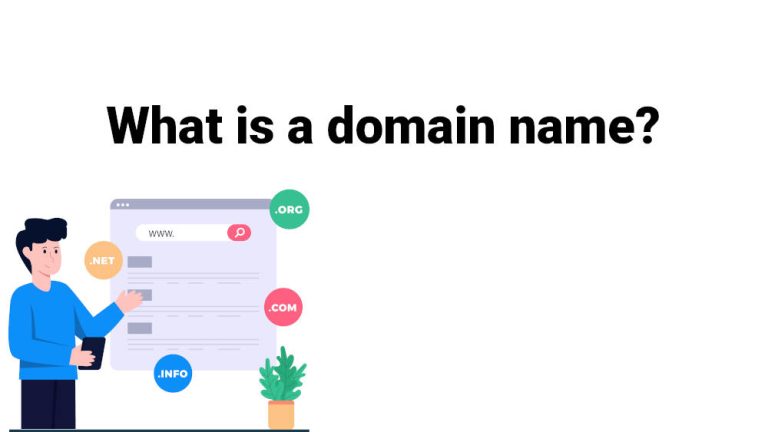A domain name is an easy-to-remember address that is used to access a specific website. A domain name is unique, and user can connect to a website using their domain names thanks to the DNS system.
Some examples of domain names: google.com, facebook.com, techie-show.com, and so on. You get it.
Basically, a domain name maps to a numeric IP address. That is the actual address of a website. But the DNS system allows users to enter human-friendly domain names and be automatically routed to the website they are looking for.
So instead of remembering 135.181.144.0 (an IPv4 address), which is this blog’s IP, you can just remember its domain name: techie-show.com.
What are the parts of a domain name?
Domain names are broken into parts, separated by a dot.
When read from right to left, a domain like google.com would be described as such:
- the TLD (top-level domain) is .com
- the 2LD (second-level domain) is google
Of course, we even have domain names like google.co.uk. In this example, the 2LD is .co and google is the 3LD (third-level domain).
Who manages these domain names?
All domain names are managed by domain registries, which delegate the reservations of domain names to registrars.
Anyone can register a domain name with a registrar. Companies like namecheap.com, for example, allow you to buy a domain name. And big companies usually allow you to choose from a plethora of TLD’s like: .com, .info, .design, .ai, .dev and so on.
Why do you need a domain name?
Because nobody would learn your server’s IP. But on a more serious note, your blog on WordPress, in order to get indexed by Google to get viewers through organic search traffic.
Also, a domain name can help your potential audience or customers to serve as a representation of you or your company on the internet. I consider the domain name a very important asset. And this brings me to another point: don’t forget to renew your domain name! You can buy and renew your domain name for 1 year, 2 years, and even more depending on the registrar and the TLD.
But you still need to make sure you keep it active, as it would be a shame to lose a domain name after you’ve had it for a couple of years and it expired.
How to choose a domain name?
There are some ideas you should keep in mind when setting out to buy a domain name for your project, idea, blog, or even online store. I’ll share my thoughts below.
Think long-term!
You should try and reflect on your future plans for what you want people to see when they reach your website. This is especially useful to have in mind for overly-niched domain names.
Make sure you mean it! It would be very strange for ‘wineshop.com’ to try and sell me construction tools.
Oh, and changing your domain name after a couple of years will be a pain, as in it will cost you some money – branding, SEO rankings, and tweaks, etc.
TLD matters, but it’s not the end of the world
The thing is, the .com TLD has been around for a while. But there are a lot more TLDs available to choose from. From new stuff like .design to country-related TLDs. Like .es for Spain or .ro for Romania.
While people are very comfortable with .com, regional/country/language TLDs also do very well in their space.
But I wouldn’t discredit other TLDs. They have some amazing naming possibilities and even outright tell people what that domain name refers to. Like .audio. A blog for a podcast that has the .audio TLD can be very fitting. There are A LOT of options.
Go for brandable names instead of generic keywords
Apart from the fact that you won’t get the SEO boost you are hoping for, you are setting yourself up to be forgettable.
A brand is much easier to advertise and create a strong online presence for than a couple of keywords. And it usually looks more professional too! (bricksandwheelbarrows.com vs constructia.com or idk, some fancy made-up brand word)
Stay short if possible
Short is better because it’s easier to remember, type, talk about etc.
But this is quite a challenge if you are aiming for a popular TLD like .com. There are A LOT of names taken already. That’s why it’s so important to make sure you don’t let any domain you already have expire. There are only so many words, names, and even possibilities.
Easy to type, easy to pronounce
This just makes it easier for people to talk about and share your domain name. Apart from the fact that you can make sure it doesn’t sound similar to something weird. Like your brand name sounding like ‘fart’ when pronounced in a hurry.
Try to avoid numbers and hyphens
Said the guy with a hyphen in his domain name.
But really, a hyphen or numbers just makes sharing harder. Imagine if Facebook were spelled like face-book. This does not mean that the hyphen would have broken the whole Facebook brand. But my guess is that it wouldn’t have helped… on the contrary.
Don’t let SEO get in the way of a great domain name
Don’t fall into this common pitfall. Making your domain name unnecessary long or stuffing keywords is not going to make or break your SEO traffic. Heck, it might do you more harm than good!
Search engines are not that dumb. Go ahead, and search for a keyword like ‘chairs’. How many of the top results have that keyword in their domain name? (not url! Domain name)
Check for trademarks or very close variations
Just to avoid confusion, try to stay away from close variations of existing websites or established brands.
And be sure to check for that specific word or wording – it might be trademarked (you can check here in the US). In that case, down the line, you might face some issues.
And that’s about it!
Make sure you choose something great, and for the love of God, don’t stress out that much on it! What you do with it, how you do it, and how serious you are will be worth a thousand times more. Work pays off.



